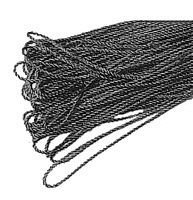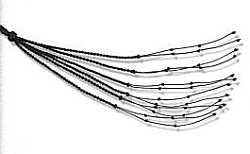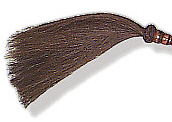Just
for the sake of having a definition, we call anything with too
many tresses to count easily, a "Flogger." 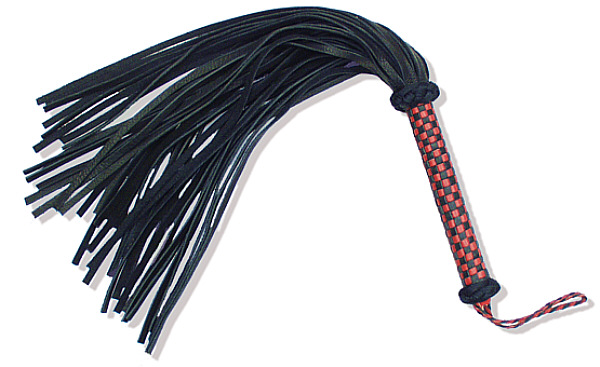
(When there are fewer tresses we call it a Cat.)
In general, floggers are kinder and gentler implements which impart a great deal of thud plus a certain amount of skin sensation. By comparison, cats are sharper, more punishing and more likely to damage skin The thicker the tress bundle, the more thud and less sting. The longer the flogger the more total power it has.
Handles
Signature Handle
Standard
on most floggers and cats, there is a surprising amount of engineering
under the surface of Adam and Gillian’s Signature
handle. First and foremost, it is built to stand up to hard use, and require
no special care. The distinctive nylon cord “French Whipping
is the same as is used ![]() on the handles of
fencing foils. It provides a no-slip grip and exceptional
durability. Each turn is locked in place individually
so that if one or more fail, the remainder will hold.
In fifteen years, not a single handle has come unraveled!
on the handles of
fencing foils. It provides a no-slip grip and exceptional
durability. Each turn is locked in place individually
so that if one or more fail, the remainder will hold.
In fifteen years, not a single handle has come unraveled!
Basket
Weave 
The square "Ear of Corn" design is created by inter-weaving two colors of leather in a tight over and under pattern. One is usually the same color, width and material as the tresses; the second color chosen to complement it. Standard on Bullwinkle and The Moosetta, it can be had on other floggers for an additional $25.00.
Strap and Cord
 Originally
used on the Alley Cat and the Black Beauty, this unusual
handle pattern is available on our other floggers for an additional $25.00.
The 1/4"wide nylon lace used in this design offers a wider choice
of colors and a subtly different appearance.
Originally
used on the Alley Cat and the Black Beauty, this unusual
handle pattern is available on our other floggers for an additional $25.00.
The 1/4"wide nylon lace used in this design offers a wider choice
of colors and a subtly different appearance.
Plain Wrap
Usually
found on our canes, rods, and small cats these attractive nylon handles
feature colors and two thicknesses of cord, finished with black plastic
end caps.
Ball
Chain 
-- A smooth ball chain can be substituted for one color of cord, at $10.00 additional cost.
The
Turk's Head knot
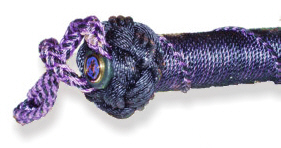
This finishing knot actually binds all the elements of the butt end of the whip together in the powerful grip of its interwoven nylon cords.
For the past 300 years the Turk's Head has adorned tillers around the world.
The Hame Ball
This is an authentic piece of horse hardware. Available in both Brass and Chrome, it is fully functional as well as beautiful and unusual. The smooth ball feels wonderful ... in the hand.

The
Claw Balls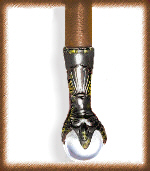
Our first Claw Ball floggers were made from the feet found on a piano stoo. that we had bought at a country auction. We subsequently found a reliable source of real Brass claw-feet, and designed our floggers to accommodate them. The glass ball sits firmly and comfortably in the hand, and the balance makes any Claw Ball Flogger very versatile and easy to use, as well as being elegant and unusual in appearance. In shiny brass or antiqued as shown.
We use a somewhat longer handle than the "Western” Style" to which many devotees have become accustomed. This is because over the years we have found that a 2:1 ratio of tress to handle length gives most people the best balance of leverage and control, consistent with “looking like a flogger.” A popular “standard” flogger is approximately 27"” long overall, having a 9"” handle and 30 tresses 3/8"” wide and 18"” long. A lower handle-to- tress ratio offers even more power and accuracy -- especially with exceptionally large tress bundles. Adam's personal Bullwinkle has nearly as much handle as tress, so that extra weight in the handle is unnecessary.
There
is a twofold purpose to these: to keep the flogger in the hand when it
is in use, and to hang it on something when it is not. The longer wrist strap
serves the first purpose very well, but with longer floggers, both wall
racks and belt clips need to be further from the floor. Finger loops will
keep the flogger“in hand”for those who use a“bullwhip-style
grip with the Turk's Head in the palm of the hand and the pinky finger
placed in the loop. It is less useful for those who like to grip the flogger
in the middle of the handle.
and to hang it on something when it is not. The longer wrist strap
serves the first purpose very well, but with longer floggers, both wall
racks and belt clips need to be further from the floor. Finger loops will
keep the flogger“in hand”for those who use a“bullwhip-style
grip with the Turk's Head in the palm of the hand and the pinky finger
placed in the loop. It is less useful for those who like to grip the flogger
in the middle of the handle.
Handle Weighting and Balance
For a nominal charge, we can load any flogger we make with a matrix of lead shot and adhesive that neither rattles nor shifts with time. However, this is a feature we'd very much like to discuss with the customer beforehand. How much weight do you want us to add?
Some people like the substantial feel of a well-weighted handle -- especially on shorter and thinner floggers. Others have definite preferences as to what constitutes“proper balance.”
Thick thumpy floggers are by their nature tress-heavy. Weight can be added to their handles to improve the balance but there is a tradeoff. The larger the tress bundle the more weight is required to balance the flogger, resulting in a flogger which can be more tiring to wield. The extra weight also produces a more powerful impact at the target.
After a certain point, it is worth considering increasing the handle's length instead of its weight.
Tresses
Comparing floggers by the number of their tresses can be a little misleading. In a tress bundle of a given weight or diameter, narrower cut gives a larger number of tresses, a thicker leather yields a smaller number -- but the amount (and cost) of the leather is the same in both cases. Bullhide, for example is nearly twice as thick as deerhide. In exceptionally thick tress bundles, a wider cut provides more sting than the narrower -- but is more slender. Leather can be made from the skin of almost any animal, bird, fish, reptile or amphibian. Far more durable and abrasion resistant than woven fibers, until the mid 20th century, leather and rawhide did almost all the jobs now done by synthetic rubbers and other plastics.
Prized by leather connoisseurs, braiding is one of the most ancient and yet sophisticated ways of working with leather. It is also one of the most appealing to the eye, decorating otherwise flat and featureless objects with a regular textured pattern.
Braided leather has practical advantages as well. When thin strings, or laces are plaited together, they are stronger, more flexible and more elastic than a single piece of the same material having the same dimensions. This is also the only practical technique for building tapered, single-tail whips more than four or five feet long.
Good braiding is inherently labor intensive and expensive. We use it for our cats and single-tails, but usually not for floggers.
Leather Types
Making leather is probably one of the earliest human skills. It is at least as old as fire-making, stone- chipping and basket-weaving -- perhaps older. To make leather, an animal skin is cleaned and treated with salts to prevent decay. To make it softer and more flexible, the tanned leather is then“"toggled"” (bent, flexed and stretched) and stuffed -- treated with oils or wax. Ancient pre-humans most likely achieved similar results by simply wrapping themselves in an animal hide until their sweat and body oil accomplished roughly the same thing. Over the next million years or so, more precise techniques of scraping, stretching and treating were developed. Sea salt and human urine were common prehistoric leather tanning agents.
Tanning in the modern sense began five or six thousand years ago when it was found that boiled tree barks would work as well as sweat and urine, and would produce a finished product that smelled much better. However, until the modern era, the tanning process itself remained one of the most filthy and malodorous of human activities. In many cultures a special underclass of untouchables was created to do this necessary work. (In fact, in the orthodox Jewish religion, being married to a tanner is reason enough for a woman to seek a divorce, no questions asked!)
In the early 19th century, chemical salts, chrome and alum were discovered as cheap and effective stabilizers for leather which produced a stronger, more durable hide, with less effort. The thinner modern leathers used for clothing, footwear and furniture are chemically tanned. The ancient vegetable tanning or "oak tanning"process is still used to make the thick strap and harness-type leathers.
When evaluating leathers, the consumer is interested in the species of animal the leather is made from, its thickness, and to a lesser degree, the production process. With the exception of some stiff, paper-thin goods from Pakistan, there is almost no really bad leather on the market anymore -- and no real reason to use it. One thing very much worth being aware of, is the language used to describe the thickness of leather.
The standard measurement of leather is in ounces. This is the actual weight of the piece (or a lot) of leather, divided by its area, which gives the weight per square foot. Expressed as thickness, an ounce equals roughly 1/64" (.375mm). Average commercial garment leather is 2-4 oz. ... heavy men's belts are made of 8 oz. leather. The thickest boot soles are made of 12-13 oz. leather.
Strong, thin and firm, Kangaroo hide is the ideal material for making lace for braiding. For this reason it is the preferred material for single-tail whip makers and prized for decorative work as well. It is not, however, the only useful braiding leather.
The black cowhide we use for floggers is an upholstery grade, (3-4 oz)) chrome tannage” with good flexibility and density. We also use a 2-3 oz. tannage which is lighter, “drier” and more cutting -- making it highly suitable for narrow floggers with a lot of sting, and which offers the widest variety of colors, and textures.
Bullhide is the industry term for thick, chrome-tanned bovine leather from fully-developed adult animals. The actual gender of the beast is not guaranteed. At Adam and Gillian's we use bullhide primarily for the tresses of thumpy floggers and occasionally as a paddle covering.
Bull- and Cowhide leather garments can be sponged with mild soap and water, cleaned and lubricated with Lexol™ or any other mild commercial leather cleaner/dressing -- but do not need periodic oiling or other special treatment. Preservation of these leathers is best accomplished by protecting them from dry heat (above 85 F, below 40% humidity) and direct sunlight. If leather becomes wet it should be gently air dried before storage to prevent mildew.
Suede is essentially leather with the skin taken off -- rough on both sides. It is offered in many colors, is soft and supple and is denser than most leathers. It is also mildly abrasive, which makes for a hot and thumpy hit, with a lot of skin reddening. The chief drawback to suede is that it absorbs body oil and environmental dirt very easily, but is difficult to clean effectively. It wears out more quickly than full grain leathers, but calls for no special care.
This is a very special leather from a long-haired sheep. It is ultra-soft, polished smooth and super-gentle. Curiously, the color of the dye changes the way the leather feels. Only the Red has the airy, supple, sensual feel that we want, so we use it for our Valentine flogger.
Deer is an extremely soft, pliable and“stretchy leather with a distinctive aroma and a texture ranging from moderately dry to slightly oily. It is velvety smooth when dragged across the skin, and will not cut or bruise, even the most sensitive. It is available in many colors including Red, Blue, Purple, Brown, Green and White -- and of course, Black.
We have had great success braiding deerhide to make a softer, gentler cat.
Moose hide or elk hide has many of the skin-pampering characteristics of deer, although it is slightly denser and usually somewhat thicker, drier and less elastic. Thick deer is roughly equivalent to thin moose.
Nylon cords offer a durable, easily cleaned alternative to leather in whipmaking. When looped, it can be stingy or thuddy, depending on the thickness of the tress bundle. When cut and knotted it is extremely cutting and can break skin. When unraveled, it is a silky, sensual cloud of fibers suitable for stroking or tickling as well as gentle flogging. We dye our own nylon in: Black, Red, Lavender, Purple, Green, Blue, Brown and Pink. We can also dye a special color on special order.
Once made of cotton, now made of nylon, Cod Line is used commercially for weaving fishing nets of all sizes. The fiber is saturated with a hard, flexible tar-like substance called asphaltum. This makes the twine heavier and denser and protects it from rot and abrasion. As a result, nets made of Cod Line sink in saltwater, and whips made from this marine material have tresses more like wire than like string.
Draw it sensually over the skin, -- or hit with it and feel the sting! But be careful, the individual hairs have microscopic barbs that can actually break skin. We mount premium quality tail-hair, suitable for musicians' bow strings in a variety of handles. Colors are black, brown, and Palomino blonde.
Whether it is used for whip tress or for a strap, rubber is known for its extreme severity. It produces very little skin damage for the amount of sensation it inflicts, and a maximum of response for a minimum of effort. Paradoxically small light rubber whips can be extremely sensual on breasts and genitals when used intelligently. In our experience, people either love it or hate it. There seems to be no middle ground.
The SandMUtopian Guardian,
published by ASWGT, Inc. 40 Grant Ave.
Copiague, NY, 11726-3817 (631)
842-1711
© aswgt, inc. 2020

